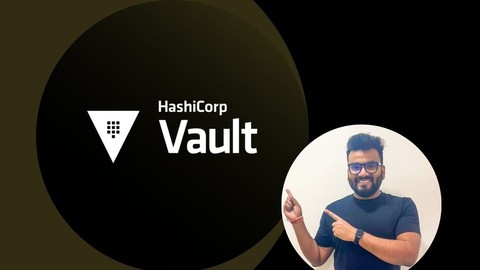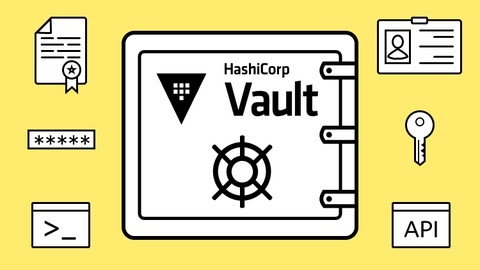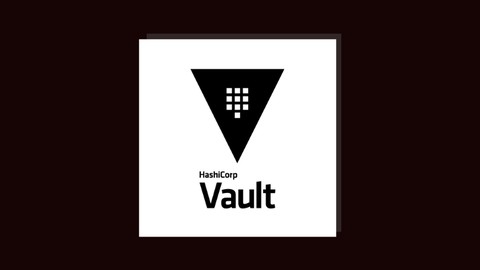HashiCorp Vault is a powerful open-source tool designed to safeguard sensitive data, such as passwords, API keys, and certificates.
In today’s increasingly complex digital landscape, securing this information is critical for organizations of all sizes.
By mastering HashiCorp Vault, you gain the ability to manage secrets effectively, control access with precision, and enhance the overall security posture of your applications and infrastructure.
Learning Vault not only equips you with valuable in-demand skills but also empowers you to contribute to a more secure digital world.
Finding the perfect HashiCorp Vault course on Udemy can feel like navigating a labyrinth of options.
You’re searching for a course that provides a solid foundation, practical hands-on experience, and expert guidance to help you confidently implement and manage Vault in real-world scenarios.
Sifting through countless courses to find the one that best suits your needs can be a time-consuming and frustrating process.
That’s why we’ve done the heavy lifting for you.
After careful review and consideration, we’ve identified the HashiCorp Certified: Vault Associate 2024 (w/ Hands-On Labs) as the best overall course on Udemy for mastering HashiCorp Vault.
This comprehensive course provides a solid foundation in Vault fundamentals, covers key concepts like authentication, authorization, and secrets management, and offers hands-on labs to reinforce your learning.
It’s the perfect starting point for anyone looking to become proficient with Vault.
However, your ideal learning path might require a different approach.
We’ve compiled a diverse selection of top-rated HashiCorp Vault courses on Udemy, catering to various skill levels and specific learning objectives.
Continue reading to explore these alternatives and find the perfect course to unlock your potential with HashiCorp Vault.
HashiCorp Certified: Vault Associate 2024 (w/ Hands-On Labs)
This HashiCorp Vault course guides you from the basics of Vault to mastering its many uses.
You learn what Vault is, its parts, and how it protects your important information.
Imagine building a secure vault from the ground up – that’s what this course feels like!
You begin by installing and setting up Vault, getting hands-on experience right away.
You learn how to “seal” and “unseal” your vault, which is like setting the combination lock and learning how to open it again.
You dive into how Vault is structured and how to navigate it.
Think of different ways to access your vault – that’s where authentication comes in.
You explore methods like UserPass, Okta, and AppRole, learning how to use them with different tools like the command line, user interface, and API.
You’ll become the master of who gets in and who doesn’t with “Vault Policies”.
Then, you unlock the power of “Vault Tokens,” which are like temporary keys with specific permissions.
You learn how to create, manage, and control these tokens, ensuring only authorized users and applications can access specific secrets.
Finally, you delve into “Secrets Engines” – imagine these as specialized compartments within your vault, each designed to hold different types of secrets.
You learn how to store, encrypt, and manage secrets for various purposes, like database credentials, encryption keys, and more.
You’ll even discover how to automate secret management using the “Vault Agent” and ensure high availability and disaster recovery through “Vault Replication.”
Managing Secrets with Hashicorp Vault
This course takes you on a journey to becoming proficient in securing and managing your sensitive data with HashiCorp Vault.
You start by grasping the fundamental concepts of secrets management and understanding why it’s crucial in today’s digital landscape.
You then dive into hands-on labs where you install Vault, learn to navigate its interface using the command line, and create your first secret.
You then explore the core building blocks of Vault: its underlying architecture, how to reference objects using paths, and how to interact with the Vault API through the command line or HTTP requests.
The course guides you through different authentication methods, including username/password, GitHub, and LDAP, ensuring you can securely access your secrets.
You’ll master the use of Vault tokens, learning how to create, manage, and revoke them, along with understanding their role in securing access to your valuable data.
A significant part of the course focuses on access authorization in Vault.
You delve into creating and managing policies, the rules that govern who can access what secrets, ensuring only authorized users and applications can access sensitive information.
You also explore various secret backends like KeyVault, AWS, MySQL, and the Transit Secret Backend.
These backends equip you to store and manage secrets across different platforms and systems, adapting to diverse security needs.
Finally, you learn how to set up auditing to track and understand access to your secrets, ensuring accountability and transparency.
HashiCorp Certified: Vault Operations Professional
This HashiCorp Vault Operations Professional course prepares you to manage and secure sensitive data with HashiCorp Vault.
You will start with the fundamentals of Vault, learning about its design, features, and how to set it up.
The course then guides you through enabling and configuring different secrets engines, such as those designed for key-value pairs, databases, and transit encryption.
You will dive into securing Vault, learning how to automatically unseal it and utilize integrated storage.
You will discover how to set up authentication methods like AppRole and Userpass, allowing you to manage who has access to your secrets.
The course then explores techniques to monitor Vault’s health and security, teaching you how to work with telemetry data, audit logs, and operational logs.
You will also explore how to make your Vault setup resilient by learning how to build high-availability clusters, configure disaster recovery replication, and integrate with Hardware Security Modules (HSM).
The course covers advanced techniques to enhance Vault’s performance.
You will discover how to leverage batch tokens, performance standby nodes, performance replication, and path filters for optimal efficiency.
You will then explore Vault’s security model, learning about identity entities, groups, policies, and how to set up access control using namespaces, Sentinel policies, and control groups.
Finally, you will learn how to work with Vault Agent.
You will discover how to use auto-auth, token sinks, and templating to automate secret management and streamline integration with other applications.
Integrating HashiCorp Vault with AWS ☁️
This course teaches you how to integrate HashiCorp Vault with AWS.
You will learn how to deploy Vault on AWS and secure it with security groups and IAM roles.
The course will show you how to use dynamic credentials, generating and rotating secrets for your applications automatically, which makes your systems more secure.
You’ll also learn how to enhance security further with multi-factor authentication (MFA) using the TOTP method.
The course goes deep into specific AWS integrations.
You will learn how to use AWS KMS for secure key management and connect Vault securely to AWS using VPC endpoints.
You will learn how to configure Vault’s Database Secrets Engine with Amazon RDS, allowing you to manage and rotate database credentials dynamically.
You will learn how to use Vault to automate backups, automatically creating snapshots of your data in Amazon S3.
Hands-on demos reinforce the material.
For example, you will see how to manage dynamic secrets for both single and cross-account access in AWS.
You will see how to configure the AWS Auth method and how to integrate CloudWatch Logs for logging and alerting.
You’ll also get practical experience working with EC2 metadata, the iam_method, and assume_role to manage access.
This course equips you with practical skills and the ability to integrate Vault with AWS securely.
You’ll leave with the knowledge and hands-on experience to improve your security posture and streamline your cloud operations.
Hashicorp Vault Management with Kubernetes via HELM
This course teaches you how to manage sensitive information, or “secrets,” in your applications using a tool called Hashicorp Vault.
You will start by learning the basics of Vault, like how to access it and use its built-in tools for storing and retrieving secrets.
You will discover different ways to control who can access your secrets, like using passwords or linking to your Github account.
Then, you will dive into deploying and configuring Vault in a real-world environment using Azure Kubernetes Cluster.
You will learn how to use HELM, a handy tool that simplifies the deployment process.
You will practice securing your Vault setup further by learning how to use both the user-friendly interface and the more powerful command-line interface.
You will also learn about using Terraform, a tool that lets you define your infrastructure using code, making it repeatable and less prone to errors.
Finally, you will explore how to keep your secrets highly available, meaning your applications can always access them, even if part of your system experiences problems.
You will learn how to set up a multi-node Vault cluster for maximum redundancy.
You will explore advanced techniques like injecting secrets directly into your application components using Sidecar and utilizing Vault Injector.
Unleash HashiCorp Certified Vault Associate Essentials
You’ll begin by discovering how Vault fits into the world of secure data management and its crucial role within enterprise environments.
You’ll then delve into Vault’s architecture, learning about its components and the essential process of setting it up securely.
You will then explore the heart of Vault – secrets management.
You’ll learn how Vault secures and manages these secrets, diving into encryption techniques using the Transit secrets engine, and understanding how to manage encryption keys effectively.
The course also covers dynamic secrets and lease management, ensuring you understand how Vault handles secrets in real-time.
You’ll then move into more advanced areas, such as setting up High Availability (HA) for Vault, guaranteeing continuous access to your sensitive data.
You’ll discover how to optimize Vault’s performance for maximum efficiency and integrate it seamlessly with identity providers for streamlined access control.
You’ll also explore how to monitor and audit Vault, learning to set up audit trails, keep an eye on performance, and troubleshoot any issues that might arise.
Finally, you’ll delve into the world of the Vault API and automation.
You’ll learn how to interact with the API through HTTP requests, automate Vault operations through scripting to enhance efficiency, and even integrate Vault into your CI/CD pipelines for a fully automated workflow.
To wrap up, the course emphasizes security best practices, teaching you how to implement robust security policies, secure your configurations, and use TLS encryption for ironclad communication channels.
Unlocking the Secrets: Hands-On HashiCorp Vault
In the “Unlocking the Secrets: Hands-On HashiCorp Vault” course, you will discover how HashiCorp Vault works and its uses.
You will gain hands-on experience installing it on your own system, using either binary installation or setting up a “dev” mode.
You will learn how to generate TLS certificates, configure Vault using a “vault.hcl” configuration file, and create a “systemd” service.
You will also learn how to initialize and unseal the Vault.
This course teaches you to navigate the Vault CLI and Vault Web UI, working with both v1 and v2 KV Secret Engines.
You will create, update, delete, and recover secrets, becoming familiar with Vault’s access control mechanisms.
You learn to write, update, and use secrets, going beyond basic management to include secret versions and secret policies.
You’ll master deleting, undeleting, and destroying secrets using the Vault CLI.
The course covers different ways to authenticate to Vault, like basic authentication, AWS authentication, and GitHub authentication.
You will explore the Vault API through the API Explorer, learning how to use it to interact with secrets.
You will practice writing, updating, getting, deleting, undeleting, and destroying secrets using the Vault API, understanding how to work with secret metadata and access older secret versions.
You will dive deeper into Secret Engines, exploring the AWS Secrets Engine, PostgreSQL Database Secrets Engine, and RabbitMQ Secrets Engine.
This course teaches you to work with Vault Policies, walking you through the process of creating, updating, and testing them.
You will understand how to create secrets, manage tokens based on policies, and implement fine-grained policies for enhanced security.
Finally, you will learn how to safeguard your root API endpoints.
Hashicorp Vault Production setup for SRE
This course on HashiCorp Vault focuses on getting you ready to use it in a production environment.
You start with the fundamentals of Vault, like understanding why it’s necessary and how sealing and unsealing contribute to its security.
You then dive into the practical setup of Vault, first in a development environment and then in a production setting.
This course is hands-on, so you’ll get to apply what you learn by building a secure production-ready Vault server.
You’ll discover how to protect your server from 18 different attack vectors.
This practical approach equips you with the skills to confidently manage Vault’s security in real-world situations.
You also learn how to control access using Vault policies and configure a Vault backend with MySQL, a popular database.
You will learn how to implement TLS/SSL for secure communication between Vault and MySQL.
The course even throws in bonus content about Site Reliability Engineers, their responsibilities, and the non-technical skills that can give you an edge in this field.








